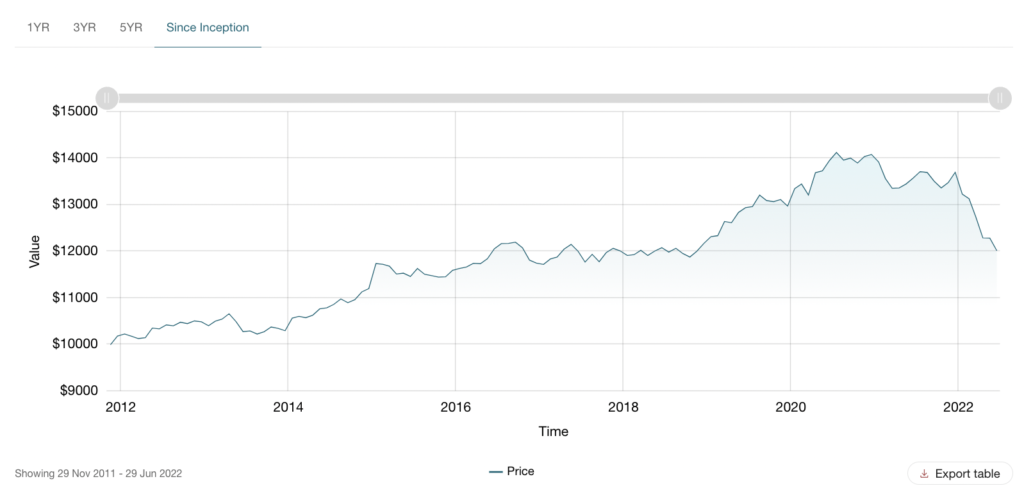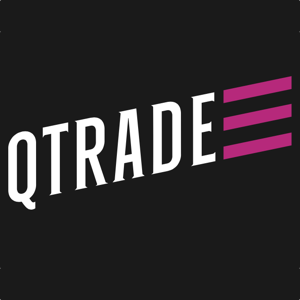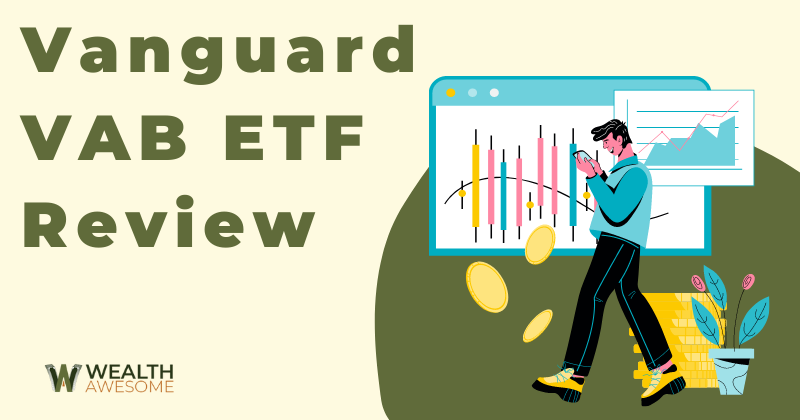Although you’ve probably heard of many equity ETFs, bond ETFs are just as important when building portfolios.
The correlation between stocks and bonds is usually negative – they tend to move in opposite directions.
Bonds tend to smooth out returns over time and reduce volatility. The main problem that investors face is that individual bonds are very hard to invest in directly.
In this Vanguard VAB ETF review, we’ll explain how to easily add diversified bonds to your portfolio.
A Core Canadian Bond ETF
An excellent, low-cost option to include in portfolios looking for diversified Canadian bond exposure.
- Low cost
- Diversified Canadian bonds
- Liquid solution
- Interest rate risk
- Average yield
What is the Vanguard VAB ETF?
VAB is a low-cost bond index fund that is offered by Vanguard Canada and launched on November 30, 2011.
VAB.TO is currently trading at close to $22.24.
Vanguard VAB Key Facts
As of July 15, 2022:
- Ticker Symbol: VAB.TO
- Exchange: Toronto Stock Exchange
- Assets Under Management: $3.214 Billion
- MER: 0.09%
- 12-Month Trailing Yield: 2.82%
- Currency Traded: CAD
- Eligible Accounts: Most registered (TFSA, RRSP, etc) and non-registered available
Vanguard VAB MER
As of July 15, 2022, the MER for VAB is 0.09%. The MER is much lower than that of bond mutual funds, which is usually around 1%.
Vanguard VAB Yield
VAB’s dividend yield as of June 30, 2022:
- 12-month trailing yield: 2.82%
- Distribution yield: 3.10%
- Dividend schedule: Monthly
Vanguard VAB Performance
Here is the performance of a hypothetical $10,000 invested in Vanguard VAB since its inception:

Showing 30 Nov 2011 – 30 Jun 2022:
| Fund Type | Month End | YTD | 1YR | 3YR | 5YR | 10YR | Since Inception |
|---|---|---|---|---|---|---|---|
| VAB (Market Price) | −1.99% | −12.26% | −11.50% | −2.43% | −0.01% | +1.50% | + 1.77% |
| VAB (NAV) | −2.20% | −12.30% | −11.50% | −2.44% | +0.02% | +1.52% | + 1.75% |
| Benchmark | −2.11% | −12.21% | −11.35% | −2.36% | +0.14% | +1.66% | + 1.91% |
Go to the Vanguard website for real-time performance numbers of VAB.
What does Vanguard VAB ETF invest in?
The VAB is a very diverse ETF, which aims to provide investors with access to high-quality, or investment grade, bonds in Canada.
VAB invests in bonds issued by both the government as well as different, high-quality companies (corporate bonds).
The majority of the bonds in the VAB have a maturity of over one year, and the bonds can be as long-dated as over 25 years out.
The VAB looks to track the Bloomberg Global Aggregate Canadian Float Adjusted Bond Index, which in plain English refers to a broadly diversified, quality Canadian bond universe.
VAB Portfolio Characteristics
When looking at a bond ETF, there are a few extra statistics to consider (versus a stock ETF).
These include looking at the duration of how much interest rate risk is involved, as well as the quality of the underlying bonds.
As of 30 Jun 2022:
| Fundamentals | Fund |
|---|---|
| Number of Bonds | 1,132 |
| Yield to Maturity | 3.9% |
| Average Duration | 7.5 years |
| Average Maturity | 10.3 years |
| Average Coupon | 2.8% |
| Short-term Reserves | 0.1% |
Duration – Interest Rate Risk
The average duration of 7.5 years is fairly high. The higher the duration of a bond ETF, the more it drops in value when interest rates rise.
A high duration also means that if interest rates fall, the bond ETF will increase in value significantly.
VAB Credit Quality – How likely are the Bonds to Default?
The credit quality of VAB is high, meaning that the bonds held in the portfolio have a very low chance of default. Bonds that are of higher quality usually pay less in coupons than their higher-risk counterparts.
As of 30 Jun 2022:
| Credit Rating | Fund | Benchmark |
|---|---|---|
| AAA | 37.4% | 37.4% |
| AA | 41.5% | 41.7% |
| A | 13.2% | 13.2% |
| BBB | 7.8% | 7.8% |
| NR | 0.1% | 0.0% |
| Total | 100.0% | 100.0% |
Vanguard VAB Distribution By Credit Maturity
As of 30 Jun 2022:
| Maturity | Fund | Benchmark |
|---|---|---|
| Over 25 Years | 13.4% | 13.4% |
| 20 – 25 Years | 6.2% | 6.3% |
| 15 – 20 Years | 5.2% | 5.1% |
| 10 – 15 Years | 5.3% | 5.3% |
| 5 – 10 Years | 27.8% | 27.9% |
| 1 – 5 Years | 42.1% | 42.1% |
| Under 1 Year | 0.1% | 0.0% |
| Total | 100.0% | 100.0% |
Vanguard VAB Sector Weighting
Over 50% of the ETF is, as of June 30, 2022, invested in some form of government bonds. These are municipal, provincial, or federal bonds.
The remaining corporate bond weighting is biased towards large sectors of the Canadian economy. These are financial institutions, agencies and industrial companies.
| Issuer | Fund | Benchmark |
|---|---|---|
| Provincials/Municipals | 39.2% | 39.3% |
| Treasury/Federal | 24.8% | 24.7% |
| Financial Institutions | 11.9% | 11.9% |
| Agencies | 10.9% | 10.9% |
| Industrials | 9.7% | 9.7% |
| Utilities | 2.3% | 2.3% |
| Supranational | 1.1% | 1.1% |
| Cash | 0.1% | — |
| Sovereign | 0.0% | 0.0% |
| Total | 100.0% | 100.0% |
VAB Top Holdings
As of June 30, 2022, the top holdings of the ETF are government bonds.
This is to be expected, as the ETF invests over 50% of its assets in high-quality government bonds. The top holdings of VAB may change over time.
| Holding Name | % of Market Value | Coupon/Yield | Maturity Date |
|---|---|---|---|
| Canadian Government Bond | 1.59% | 1.50% | 01 Jun 2031 |
| Canadian Government Bond | 1.48% | 2.00% | 01 Dec 2051 |
| Canadian Government Bond | 1.40% | 1.50% | 01 Dec 2031 |
| Canadian Government Bond | 1.37% | 1.25% | 01 Jun 2030 |
| Canadian Government Bond | 1.07% | 2.75% | 01 Aug 2024 |
| Canadian Government Bond | 1.02% | 0.50% | 01 Dec 2030 |
| Canadian Government Bond | 0.92% | 1.50% | 01 May 2024 |
| Canadian Government Bond | 0.91% | 0.25% | 01 Mar 2026 |
| Canada Housing Trust No 1 | 0.91% | 2.90% | 15 Jun 2024 |
| Canadian Government Bond | 0.86% | 1.25% | 01 Mar 2027 |
Vanguard VAB Region exposure
As of 30 Jun 2022:
| Region | Fund |
|---|---|
| North America | 97.90% |
| Other | 1.10% |
| Europe | 0.90% |
| Pacific | 0.10% |
| Total | 100.00% |
Vanguard VAB Market Allocation
As of 30 Jun 2022:
| Country | Region | Fund | Benchmark |
|---|---|---|---|
| Canada | North America | 95.4% | 95.4% |
| United States of America | North America | 2.6% | 2.5% |
| Supranational | Other | 1.1% | 1.1% |
| Germany | Europe | 0.4% | 0.4% |
| United Kingdom | Europe | 0.3% | 0.3% |
| Other | Other | 0.1% | — |
| Australia | Pacific | 0.1% | 0.1% |
| France | Europe | 0.0% | 0.0% |
| Belgium | Europe | 0.0% | 0.0% |
| Austria | Europe | 0.0% | 0.0% |
| Total | 100.0% | 99.8% |
Vanguard VAB Risk and Volatility
As of 30 Jun 2022:
| Fund Type | R-Squared | BETA | ALPHA | Standard Deviation | Sharpe Ratio |
|---|---|---|---|---|---|
| Fund | 1.00 | 1.00 | − 0.01 | 5.69% | -0.54 |
| Benchmark | — | — | — | 5.69% | -0.52 |
VAB vs Other Funds
It’s important to compare apples to apples when looking at different ETFs or funds. As a high-quality, higher-duration Canadian bond ETF, we can compare VAB to ETFs with similar features.
VAB vs ZAG
BMO’s ZAG ETF is comparable to VAB, with the exception that it is entirely invested in Canadian government bonds. This makes ZAG safer from a credit quality perspective.
The MER of ZAG is the same, at 0.09%.
As of June 30, 2022, ZAG’s duration is 7.39 is slightly lower than VAB’s. Although this is not a significant amount, it will be slightly more volatile when interest rates shift.
Compared to VAB, ZAG has had a much worse performance recently. It does have a longer track record, which includes good years for bond performance (and a higher since inception return).
As of June 30, 2022:
| 1 Year | 2 Year | 3 Year | 5 Year | 10 Year | Since Inception | |
|---|---|---|---|---|---|---|
| NAV | -11.53% | -7.10% | -2.41% | 0.04% | 1.53% | 2.51% |
| Index | -11.39% | -7.02% | -2.30% | 0.17% | 1.71% | 2.73% |
VAB vs QBB
Mackenzie’s QBB ETF is very similar to VAB in terms of the bonds held in its portfolio.
QBB has an MER of 0.08%, which is slightly lower than VAB’s.
QBB has a higher duration (9.12 as of June 30, 2022), which means more interest rate volatility for investors.
The performance of QBB has also been slightly better over most time frames:
As of June 30, 2022:
| Compound Annualized Returns | Fund NAV % |
| 1 Month | -2.1% |
| 3 Months | -5.6% |
| Year-to-date | -12.1% |
| 1 Year | -11.3% |
| 2 Years | -6.8% |
| 3 Years | -2.2% |
| Since inception (Jan. 2018) | 0.2% |
VAB vs XSAB
Blackrock’s iShares XSAB ETF is also a good comparable ETF, with the added element of ESG selection.
What is ESG?
ESG screening is a way to look at investments and quantify them as being responsible or not. ESG stands for:
E – Environment
S – Social
G – Governance
Responsible investing has become more of a trend over the past several years. If you are looking for a similar bond ETF, with the added benefit of ESG analysis, XSAB is a great alternative.
Since there is the ESG component to the ETF, the MER is much higher, at 0.17%.
XSAB has a slightly lower duration (7.45 as of July 21, 2022), meaning less interest rate volatility.
Performance has also been fairly similar as of June 30, 2022:
| 1y | 3y | 5y | 10y | Incept. | |
|---|---|---|---|---|---|
| Average Annual Return (%) | -11.13 | -2.44 | – | – | -1.26 |
| Benchmark (%) | -10.96 | -2.25 | – | – | -1.09 |
Comparing Statistics between ETFs
When looking at any risk or performance metrics for ETFs or funds, it’s important to look at a fund’s inception date.
This will have a big impact on the inception performance of the fund and is usually different between funds.
The time period of the statistics is also very important. VAB, QBB, and XSAB have recent performance figures as of June 30, 2022.
This makes them easier to compare over the same time period.
What about Buying Bonds Directly?
Another possible alternative to buying the VAB ETF is to buy some or all of the individual underlying bonds directly.
There are several key differences between holding an individual bond and buying a bond ETF.
Buying a Bond ETF
A bond ETF is a group of bonds that are constantly bought and sold over time to maintain a specific investment exposure.
This means that there is no set maturity date for the bond, and the majority of the ETF’s statistics are constantly changing over time.
Buying Individual Bonds
Buying bonds individually can save you from paying fund MERs. Investing in individual bonds is difficult because it requires a lot of capital to put together a well-diversified portfolio.
Bonds are traded over the counter and are usually much less liquid than stocks. The minimum investment for buying individual bonds is also fairly high.
Holding to Maturity
Buying an individual bond instead of a bond ETF has a key benefit – the option to hold the bond until maturity.
Bond prices are usually impacted by changes in interest rates, but this is eliminated by holding a bond until it matures.
If you hold an individual bond until maturity, you will be paid your principal back, as well as the coupons along the way.
The main risk to an investor holding until maturity is the chance the bond issuer will default.
A bond ETF does not have a maturity date, and a long period of rising interest rates can be disastrous for bond ETF investors.
How to Buy Vanguard VAB ETF in Canada
The cheapest way to buy ETFs is from discount brokers. My top choices in Canada are:

- 105 commission-free ETFs to buy and sell
- Excellent customer service
- Top-notch market research tools
- Easy-to-use and stable platform

- Stock and ETF buys and sells have $0 trading fees
- Desktop and mobile trading
- Reputable fintech company
- Fractional shares available
To learn more, check out my full breakdown of the best trading platforms in Canada.
Our Final Verdict

You should buy the VAB ETF if:
- You want a low-fee passive investing solution that tracks the Canadian aggregate high-quality bond market
- You need Canadian fixed income exposure as part of your overall asset allocation
- You are looking for monthly income from a core fixed income position in your Canadian portfolio
VAB achieves what it sets out to accomplish, which is why we highly recommend it as a part of your fixed-income portfolio.
VAB is low-cost, provides diverse exposure to quality Canadian bonds, and is extremely liquid.
A single bond ETF is usually not enough to properly diversify your entire fixed-income portfolio. Make sure to consider other great ETFs in the global and high-yield bond space.






